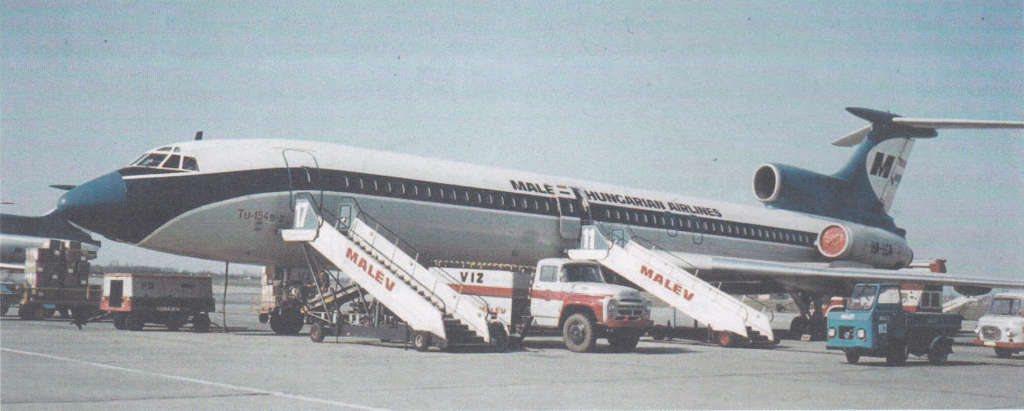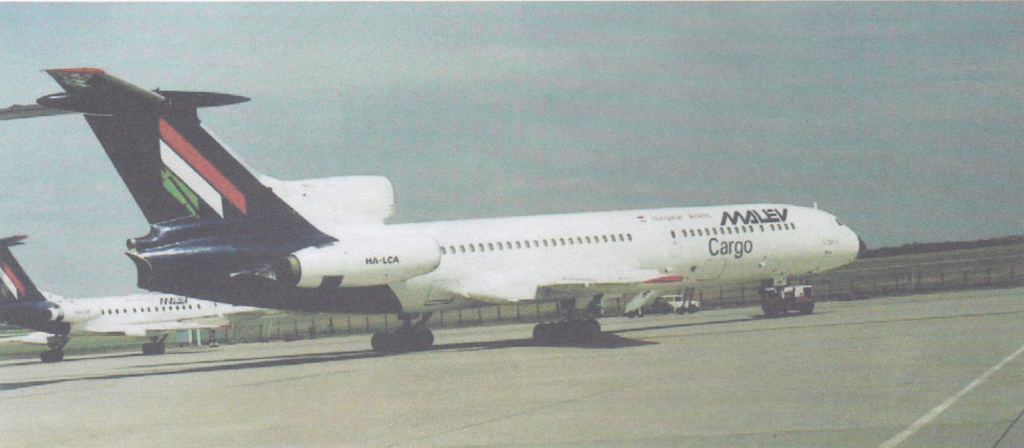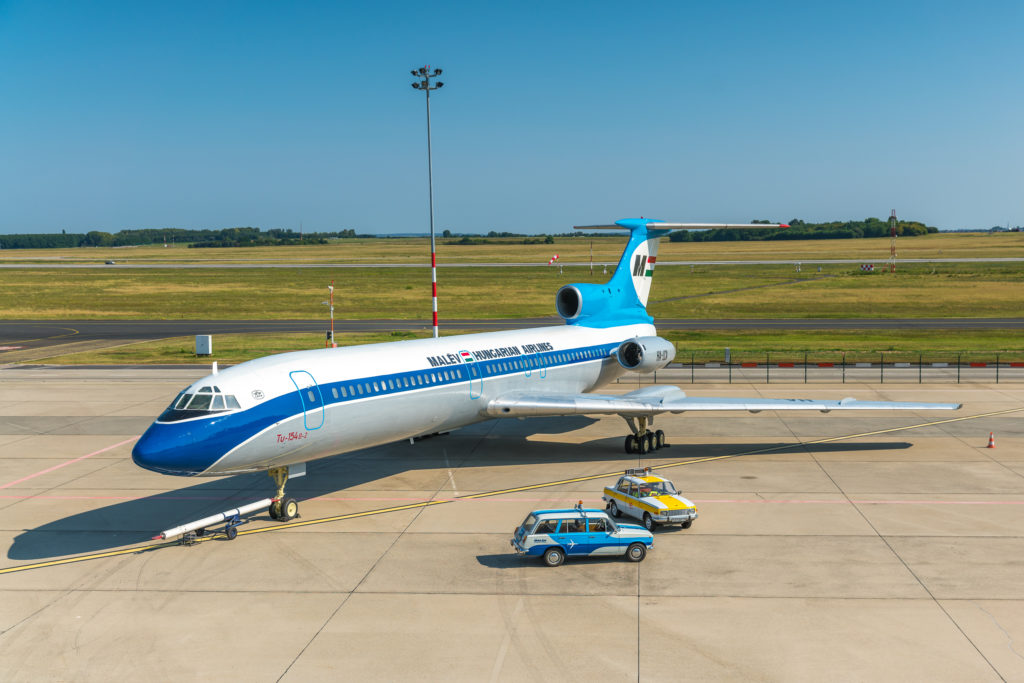LCAladár története
|
The story of HA-LCA
|
| A típus első gépét 1973. augusztus 9-én bocsátották ki a gyárból, 47 479 kg üres tömeggel és 49,6 KAH% súlyponthelyzettel. A berepülési programja szeptember 4-ig tartott, mely 9 felszállásból állt és ezalatt, összesen 20 óra 25 percet repült. Hazaérkezés után szeptember 12-én gyakorlórepülést, majd másnap, 1973. szeptember 13-án a típus első forgalmi útját teljesítette. |
The first aircraft of this type was released from the factory on August 9, 1973, with an empty weight of 47 479 kgs and 49,6% empty Centre of Gravity. The test flight programme consisted of 9 takeoffs, during which the plane flew 20 hours and 25 minutes. After coming home it flew a training flight, then the next day marked the first commercial flight in September 13, 1973. |
 |
| Szeptember 29-én Aladáron végezték el a Malév és a magyar repülés történetében a típus első 50 órás karbantartását. A hajtóművek azonban nem tudták ledolgozni az engedélyezett 200 repült órát, mert meghibásodás miatt rövidesen mindhármat cserélni kellett. 1975. május 25-én kirepült a gyárba bulletines munkákra és csak az év végén, december 7-én jött haza. |
The first ever 50 hour maintenance in Malév’s and the hungarian aviation’s history on this type was performed on this plane on September 29. The engines could not complete their authorized 200 flight hours as shortly all 3 had to be replaced due to issues. On May 25, 1973 the plane flew to the factory for bulletin works, from which it only returned at the end of the year, on December 7. |
| 1977-ben elérte az 5 000., 1981-ben a 10 000. repült óráját. 1978-79-ben az első generáljavításán átalakították B2-es változatba, ahonnan a gép már 153 fős változatban érkezett haza. A gép üres tömege 51 194 kg-ra nőtt. 1981. június 24-én a Ferihegyi leszállás után, intenzív esőben a gép kitört jobbra és legurult a futópályáról, de sikeresen visszakormányozták a betonra. 1982. október 19-én Aladár volt először a készülő új műszaki bázison, ott is az 1-es hangárban, ahol a típus szerelő dokkjainak próbái folytak. |
In 1977 it reached the milestone of 5 000 hours, and by 1981 it had already spent 10 000 hours in the air. During the first major overhaul it was upgraded to B2 from which it returned with a cabin configuration of 153, increasing its empty weight to 51 194 kgs. On June 24, 1981 the plane had a runway excursion incident after landing in intense rain at Ferihegy, but the crew managed to steer it back onto the paved surface. On October 19, 1982 this plane was the first to visit the new maintenance facility, namely Hangar 1, where the docks for the maintenance were tested. |
| 1982. November 27-én az MA121-es járaton Leningrádból hazafelé Varsóban felszállt a gépre egy fegyveres kiskatona, aki arra akarta kényszeríteni a személyzetet, hogy repüljön Nyugat-Berlinbe vagy Bécsbe. Több utast is elengedett, majd hosszas alkudozás után a férfi átszállt egy lengyel An-24-es gépbe, ahol elfogták. Aladár volt az első Tu-154-es induló gép a 2-es terminál utasforgalmi próbáján 1985. November 24-én. 1991 Szeptemberébn a 18 éves gépet átépítették teherszállítóvá és növelték az élettartamát 21 évre, ekkor került a gép oldalára a „Cargo” felirat. Utolsó útjára június 6-án indult, Budapestről Tashkentbe vitt élő állatot, csirkét és 8-án érkezett haza. |
On November 27, 1982 on the flight MA121 from Leningrad in Warsaw an armed soldier had boarded the plane, who demanded that the crew fly it to West Berlin or Vienna. He released several passengers and after long negotiations he boarded a polish An-24 where he was captured. HA-LCA was the first departing plane during the passenger testing period of the new Terminal 2 on November 24, 1985. In September 1991 the 18-year old plane was converted into freighter and it’s life-span was extended to 21 years, also a „Cargo” label was painted on both sides of the fuselage. The last commercial flight performed was on June 6 to Tashkent, carrying live animals, chickens, it returned on June 8. |
 |
| A forgalomból kivont repülőgép a Készenléti Rendőrség tulajdonába került, levontatták a repültőtér kerítése mellé, ahol gyakorlatokra használták. Innen 2014 tavaszán, hosszú kutató- és előkészítő munka után a Légiközlekedési Kulturális Központ birtokába került a már évek óta használaton kívül lévő repülőgé, és fel lett vontatva az Aeroplex of Central Europe és a Lufthansa Technik műszaki előterek közötti füves területre, hogy megkezdődhessenek a felújítási munkálatok. Ezek hamarosan félbemaradtak, miután az LKK üzemeltetésébe került át a Ferihegyi Repülőmúzeum, így minden erőforrás ennek felfuttatására irányult. Az LKK 2018-ban jutott el arra a szintre, hogy az immár Aeropark névre átkeresztelt múzeum Közép-Európa egyik vezető légiközlekedési látogatóközpontjává fejlesztése után és a kerek évforduló okán ismét előtérbe kerüljön a projekt. |
The airplane after being removed from active duty was transferred to the hungarian police forces, after which it was towed next to the airport’s perimeter fence and was used for trainings for a number of years. From this point after a long research and preparation period the Aviation Cultural Centre took posession of it in spring of 2014, the plane was towed up onto the grass surface between the Aeroplex of Central Europe and Lufthansa Technik maintenance aprons, so the restoration works could begin. These however have been suspended shortly after as the Company took over the management of the Ferihegy Avaiation Museum, all the resources were redirected. The Company in 2018 after developing the museum to become one of Central Europe’s leading aviation visitor center has now re-launched this restoration project. |
 |